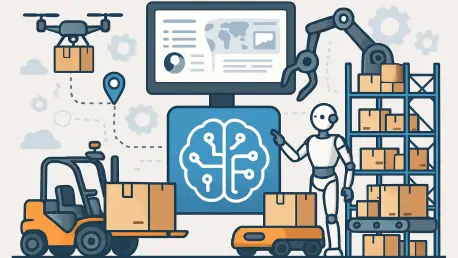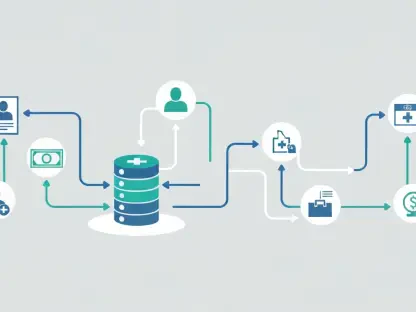In an era where global supply chains are stretched thin by unprecedented demand and persistent labor shortages, the logistics industry stands at a critical crossroads, grappling with inefficiencies that threaten to derail operations on a massive scale. Rising customer expectations for speed and reliability only intensify the pressure, as companies struggle to manage complex workflows with limited human resources. Amid this chaos, artificial intelligence (AI) emerges as a potential lifeline, offering innovative solutions to automate repetitive tasks and build a digital workforce capable of transforming the sector. Startups are stepping up with cutting-edge platforms designed to alleviate the burden of manual labor, allowing human teams to focus on strategic priorities. This article delves into the promise of AI in logistics, examining how it addresses systemic challenges, enhances operational efficiency, and sets the stage for a future where technology and human ingenuity work hand in hand to redefine the industry.
Addressing the Weight of Manual Processes
The logistics sector has long depended on manual labor for critical yet mundane tasks, such as scheduling deliveries, negotiating freight rates, and processing payments, often outsourcing these functions to call centers that struggle to keep up with demand. This heavy reliance creates a cascade of inefficiencies, with missed deadlines and communication breakdowns becoming all too common as overwhelmed teams juggle high-volume workloads. Human workers find themselves trapped in a cycle of repetitive coordination, leaving little time for nurturing client relationships or tackling strategic goals. The cost of these inefficiencies is not just financial but also operational, as delays and errors erode trust and competitiveness in a fast-paced market. AI presents a compelling alternative by stepping in to handle these time-intensive responsibilities, promising to streamline processes and free up valuable human capital for more impactful contributions to business growth.
Beyond the immediate relief from repetitive tasks, the integration of AI into logistics operations offers a chance to rethink how workflows are structured and managed across the board. By automating routine interactions—whether through phone calls, emails, or digital platforms—AI systems can ensure consistency and accuracy that human teams, under constant pressure, might struggle to maintain. This shift does not merely patch over existing problems but fundamentally alters the operational landscape, reducing the risk of burnout among staff and minimizing the errors that plague manual systems. For companies bogged down by fragmented processes and outdated methods, the adoption of AI could mark a turning point, enabling a more agile response to market demands. As the technology proves its worth, it becomes clear that addressing manual inefficiencies is not just about cutting costs but about building a foundation for sustainable scalability in an increasingly complex industry.
Unleashing AI’s Potential as a Virtual Workforce
AI platforms are redefining logistics by deploying virtual workers that manage end-to-end operational tasks with remarkable precision, tackling everything from appointment scheduling to real-time stakeholder updates across multiple communication channels. Unlike traditional automation tools bound by rigid scripts, these digital employees adapt to dynamic, real-world scenarios, ensuring seamless interactions that mirror human capability without the associated fatigue or error rates. Major logistics giants have already seen transformative results, with resolution times for critical tasks shrinking dramatically and returns on investment in areas like collections and sales reaching impressive heights. This dual impact—slashing operational costs while boosting revenue—underscores AI’s potential to not only support but actively enhance business outcomes, positioning it as a cornerstone of modern logistics strategies.
The broader implications of a virtual workforce extend far beyond immediate metrics, reshaping how companies approach scalability and customer satisfaction in a competitive landscape. By offloading high-volume, repetitive tasks to AI, human employees are empowered to focus on building stronger relationships with clients and addressing complex challenges that require creative problem-solving. This reallocation of focus can lead to improved service quality, as teams are no longer bogged down by administrative burdens but instead prioritize strategic initiatives that drive long-term value. Moreover, the consistency and reliability of AI-driven interactions help build trust with partners and customers, ensuring that commitments are met without the delays often associated with manual processes. As these virtual workers become more integrated into daily operations, they lay the groundwork for a logistics ecosystem that thrives on efficiency and innovation.
The Technological Engine Driving Change
At the heart of AI’s impact on logistics lies a sophisticated blend of technologies, combining capabilities like transcription, natural language processing, and voice generation with seamless integrations into existing systems such as transportation management software and customer relationship tools. These platforms go beyond generic solutions by offering tailored features, including compliance auditing to meet regulatory demands and customizable automation to fit unique business needs, ensuring reliability at an enterprise level. Dedicated engineering support further enhances this adaptability, allowing for rapid deployment and fine-tuning of workflows to deliver measurable results in record time. This technological synergy addresses the intricate demands of supply chain management, providing a robust framework that can evolve with the industry’s shifting priorities.
Equally important is the scalability that such advanced systems bring to logistics operations, enabling businesses to handle growing volumes without the proportional increase in overhead costs typically associated with expansion. The deep integration with operational software ensures that AI tools are not standalone fixes but part of a cohesive strategy, pulling data from multiple sources to make informed decisions in real time. This interconnected approach minimizes disruptions and maximizes efficiency, as tasks are executed with precision across various touchpoints. For companies navigating the complexities of global supply chains, the ability to rely on a technology stack that anticipates and resolves issues before they escalate is invaluable. As these platforms continue to refine their capabilities, they promise to not only keep pace with industry growth but to actively drive it by setting new standards for operational excellence.
Confronting Systemic Industry Pressures
Logistics faces a perfect storm of challenges, from escalating supply chain complexity to fragmented software ecosystems that hinder seamless operations, all while labor shortages and call center burnout add to the strain on human resources. The pressure to deliver faster and more reliably has never been greater, yet the tools and workforce available often fall short, leading to spiraling costs and diminished service quality. Human teams, stretched thin by relentless demands, struggle to maintain the balance between speed and accuracy, often at the expense of both employee well-being and customer satisfaction. AI emerges as a scalable countermeasure, automating high-volume coordination tasks to reduce the burden on staff while delivering consistent, auditable results that address these deep-rooted inefficiencies head-on.
The adoption of AI in logistics also offers a pathway to mitigate the fragmentation that plagues many organizations, where disparate systems and manual processes create bottlenecks at every turn. By centralizing operations through intelligent platforms, companies can achieve a level of cohesion that was previously unattainable, ensuring that data flows smoothly between departments and partners. This unified approach not only cuts down on errors but also speeds up decision-making, allowing businesses to respond swiftly to disruptions or shifting market conditions. Furthermore, the relief provided to human workers by automating repetitive tasks can improve morale and retention, addressing labor shortages from a cultural as well as operational perspective. As AI solutions become more entrenched, they hold the potential to transform these systemic pressures into opportunities for growth and resilience.
Envisioning a Smarter Logistics Landscape
Looking ahead, the integration of AI into logistics paints a picture of an industry where digital workforces are not just a novelty but a fundamental component of daily operations, poised to tackle both current inefficiencies and future hurdles. Companies embracing this technology are laying the groundwork for a shift from labor-intensive models to ones driven by strategic innovation, where human expertise is amplified by AI’s tireless efficiency. With substantial financial backing and proven outcomes already emerging, pioneers in this space are setting a precedent for how logistics can evolve, moving beyond mere automation to a holistic reimagining of operational dynamics. The trajectory suggests that the industry is on the cusp of a major transformation, with AI acting as a catalyst for smarter, more responsive systems.
This vision of a smarter logistics landscape also hinges on continuous advancement and broader adoption, as businesses recognize the competitive edge gained from AI-driven operations over the coming years. Investment in scalable platforms will likely accelerate, fueled by the need to stay ahead in a market that rewards agility and precision. For stakeholders, the focus should shift toward identifying areas where digital workforces can deliver the most impact, whether in streamlining last-mile delivery or optimizing inventory management. Collaboration between technology providers and logistics firms will be key to refining these tools, ensuring they meet real-world needs with minimal friction. As the journey unfolds, it becomes evident that the steps taken now to integrate AI are reshaping the industry, offering a blueprint for balancing technological innovation with human insight to build a more robust future.









